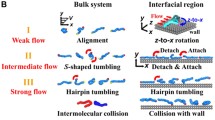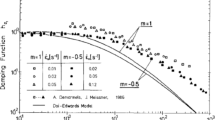Abstract
In this paper, a network model of polymer melts is proposed in which network junction points move non-affinely. In this non-affine motion, junction points follow particle paths as seen by an observer rotating at the fluid element's net rigid-rotation rate. The speed at which junction points move is reduced as the network segments near their maximum extensions. In order to maintain a frame invariant model, it is necessary that the vorticity be decomposed into two portions, such that, ω = ω R + ω D . The deformational vorticity, ω D , arises from shear deformation and is frame invariant while the rigid vorticity, ω R , is frame dependent. A constitutive equation based on this finitely extensible network strand (FENS) motion is developed. The model illustrates how rotations that cause changes in the relative orientation of a fluid element with its surroundings can be incorporated into a constitutive equation using the deformational vorticity. The FENS model predicts a shear-thinning viscosity, and the Trouton viscosity predicted by the model is finite for all elongation rates. Finally, stochastic simulation results are presented to justify a mathematical approximation used in deriving the constitutive equation.
Similar content being viewed by others
References
Baer TA, Finlayson BA (1988) Comparison of model predictions with experimental entrance pressure data. Presented at 1988 AICHE annual meeting, Washington, D. C., November 30, 1988
Bird RB, Curtiss CF, Armstrong RC, Hassager O (1987) Dynamics of polymeric liquids, Vol. 2. Kinetic Theory, 2nd edn., Wiley-Interscience, New York
Green MS, Tobolsky AV (1946) A new approach to the theory of relaxing polymeric media. J Chem Phys 14(2):80–92
Keunings R, Crochet MJ (1984) Numerical simulation of the flow of a viscoelastic fluid through an abrupt contraction. J Non-Newtonian Fluid Mech 14:279–299
Kolka RW, Malkus DS, Rose TR (1991) Finite rise time step strain modeling of nearly monodisperse polymer melts and solutions. Rheol Acta 30:430–446
Lodge AS (1956) A network theory of flow birefringence and stress in concentrated polymer solutions. Trans Faraday Soc 52:120–130
Peterlin AJ (1966) Hydrodynamics of macromolecules in a velocity field with longitudinal gradient. J Polym Sci Polym Lett 4B:287–291
Petruccione F, Biller P (1988a) A numerical stochastic approach to network theories of polymeric fluids. J Chem Phys 89:577–582
Petruccione F, Biller P (1988b) Rheological properties of network models with configuration-dependent creation and loss rates. Rheol Acta 27:557–560
Phan-Thien N, Tanner RI (1977) A new constitutive equation derived from network theory. J Non-Newtonian Fluid Mech 2:353–365
Phan-Thien N (1978) A nonlinear network viscoelastic model. J Rheol 22:259–283
Thomas GB, Finney RL (1979) Calculus and analytic geometry, 5th edn. Addison-Wesley, Massachusetts
Wagner MH (1979) Zur Netzwerktheorie von Polymer-Schmelzen. Rheol Acta 18:33–50
Author information
Authors and Affiliations
Rights and permissions
About this article
Cite this article
Wedgewood, L.E., Geurts, K.R. A non-affine network model for polymer melts. Rheola Acta 34, 196–208 (1995). https://doi.org/10.1007/BF00398439
Received:
Accepted:
Issue Date:
DOI: https://doi.org/10.1007/BF00398439




